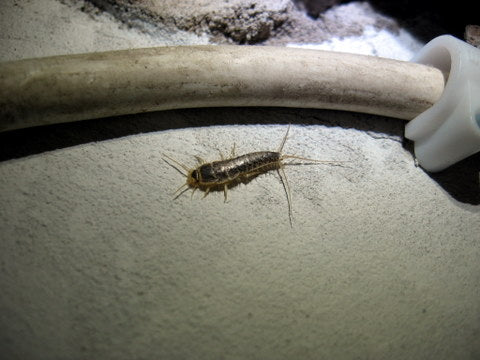
Rats in a subway. Image by edenpictures on Flickr
Rats – a true horror in any home. These rodents are highly intelligent and will eat most anything in their way. They hide in cracks and crevices, squeezing their bodies under door gaps and getting into the smallest places. When the sun goes down, they come out to scavenge for food and water in kitchen pantries and cabinets; some can even find ways to get inside the refrigerator.
The rat is part of the order Rodentia, a group of mammals with teeth that continue to grow throughout their lifetime. In order to prevent health problems, these mammals must frequently gnaw on various objects to wear down their teeth. Otherwise, the teeth could overgrow and prevent them from being able to eat. The teeth could also grow through their jaws and cause permanent damage or death.
Where Do Rats Come From?
Were rats always here, or did they come here through an invasion like many other pests do? Black and brown rats come from Asia, so they were definitely introduced to other parts of the world through trade and other means of transportation. There aren't many places in this world that rats haven't infested, and they can be found in every state in America.
There are 51 rat species in the world, ranging from the common brown rat, also known as the Norway rat, and the black rat, also referred to as the roof rat. Each species has its own defining traits and characteristics and inhabits various places in the world. They can be found in everything from sewers to attics and will build nests in any shelter they can find.
The common black rat began its existence in Asia and eventually spread into Europe. As European colonies spread, so too did the rats until they eventually inhabited every land mass in the world. In fact, there are about as many rats in this world as there are people, with about 6 billion or more in every country and continent on Earth.
Two Common Rats to Look Out For

A brown rat - Wikipedia
The two most common rats to watch for in homes and businesses across the world are the Norway rat and the roof rat. Both rats look similar but have differences that help to tell them apart.
-
Norway Rat:
- Thick, blunt-shaped noses
- Small eyes
- Tiny ears
- Large, thick bodies
- Tails that are shorter than the head and body
-
Root Rat:
- Thin, pointed noses
- Large eyes
- Large ears
- Thin, sleek bodies
- Tails that are longer than the head and body
As seen in the list, the Norway rat is larger than the roof rat and can also be identified by its brown, stocky body. Don't be fooled, though, because roof rats can also be dark brown or black in color. If spotted, it's important to use the other characteristics to identify the species.
Both rat species are social rodents and prefer to live in colonies. Each colony will have an alpha leader, acting almost like a wolf pack. Whereas Norway rats are most often found in buildings on the ground level, such as the basement or the crawlspace, roof rats are found in a variety of places indoors and outdoors, such as in:
- Sheds
- Garages
- Walls
- Attics
- Trees
A black rat and its teeth - Wikipedia
Other Common Rats in North America
Though the brown and black rats are the most common species in the United States, other rats can also be found across the country. Let's take a look at two other species that may find their way into homes depending on the region.
-
Wood Rat:
- Wood rats are also known as pack rats because they like to take things and hoard them in their nests. They're grayish-brown in color and have large ears, a long tail and bulging, black eyes. They're found mostly in the Western United States, ranging from Canada to Arizona and New Mexico.
-
Marsh Rice Rat:
- The marsh rice rat is another common rodent in the U.S., found mainly in the Gulf Coast region and across the Southeast to Texas. It's gray or grayish-brown in color and grows up to 12 inches in length. It has small ears, a long tail and small, beady eyes.
There are other rats in the U.S., such as the Gulf Coast kangaroo rat. These rats are usually confined to one state or a very small area in the country. The four mentioned in this section are very common and easily identifiable due to their markings and the regions in which they're found.

A rat eating food on the floor - Pixabay
What Do Rats Eat?
Most rats will eat anything they can find, whether it's insects or seeds. Some will eat bird eggs while others prefer fish and crabs. When it comes to common rats in America, their diet is consistent to their region:
-
Norway Rat Diet:
- Small birds
- Eggs
- Plants
- Insects
- Small invertebrates
-
Roof Rat Diet:
- Seeds
- Dog and cat food
- Small birds
- Fruits
- Leaves
-
Pack Rat Diet:
- Seeds and nuts
- Berries
- Insects
- Twigs
- Small birds
-
Marsh Rice Rat Diet:
- Vegetation
- Fungi
- Rice
- Fish and crabs
- Snails
Never touch a dead rat - Image on Wikipedia
What are Some Rodent Diseases?
Diseases are quite common in the rodent kingdom, and many of these viral and bacterial diseases can be transmitted to people. Touching an infected rat, whether it's contact with the animal or the feces, can spread the disease and cause health complications.
People can also become sick from rodent-borne diseases just by inhaling a virus that's found in the rat's urine or saliva. These pest animals are capable of spreading over 35 diseases to people, causing sickness and even death in some extreme cases. The diseases are spread through direct handling with live or dead rats, by inhaling the viruses or getting bit by an infected rat.
Taking a look at the four common rats in the U.S., let's discover a few of the most common diseases that these rodents can transmit to humans:
-
Norway Rat Diseases:
- Weil's Disease, or Leptospirosis, is a bacterial infection that's transmitted through rat urine-infested water. It can cause flu-like symptoms and eventually lead to death due to heart and liver failure if it's not treated.
-
Roof Rat Diseases:
- Murine typhus is a common disease carried by roof rats, as well as other diseases such as leptospirosis. It is transmitted through the bites of infected fleas that have infested these rodents.
-
Pack Rat Diseases:
- Pack rats are known for spreading several diseases such as hantavirus, typhoid and the bubonic plague. These diseases can transmit to people through direct contact with dead or live rats and their feces.
-
Marsh Rice Rat Diseases:
- Marsh rats carry diseases such as bayou virus, which is an agent of hantavirus. They're also known to transmit bartonella, a bacteria that is transmitted through flea and lice bites.
Keep in mind that many rats may carry several bacteria or viruses at one time and can transmit them not only through direct contact but also through the bites of their fleas and lice. Simply breathing in rat dander or cleaning up a dead rat can make it easy to catch a disease from these rodents.
Three rat babies - Image on Wikipedia
The Rat Reproduction Cycle
Rats become a nuisance so quickly because of how fast they reproduce. A single female rat can produce up to eight young with each litter, and they're born within 22 days.
DID YOU KNOW?
It only takes young rats to become fully mature adults in just five to six weeks? That's incredible and why they become an infestation so quickly.
Norway females can have as many as six litters per year while roof rat females has up to five. There are about three to eight young with each litter, totaling as much as 40 rats from one female alone in a single year. The young are well taken care of during their immature stages since they're eyes have yet to open. Within a week, they're opening their eyes and already investigating their surroundings.
At three months, the young are sexually active and able to reproduce and start the cycle over. Because the rodents tend to live in colonies, it doesn't take long for it to grow beyond control. If a colony has infested a house, it will completely take over the interior within one year. The older rats will also continue to mate, causing a rapid population explosion.
Even in a non-suitable climate, a female rat can have three litters, each with three young, in one year. If the rat lives nine years and produces three litters each year, she will have produced as many as 81 young in her lifetime. As her young grow and produce, the more the infestation will grow. That's why it's important to take pest control action at the first sign of the rodents.
What is the Rat Life Cycle?
Let's recap what we've go through so far and expand on it a little more:
- Young rats are born about 20 days after conception.
- The young nurse for approximately one or two months.
- Young rats reach sexual maturity in just three months.
- The rodents reproduce between three and five times per year.
- They can live eight, nine or longer in years.

A rat in a box - Image on Defense.gov
What Do Rats Eat? Where do Rats Live?
People have a problem with rats because of what they eat, where they live and the illnesses they spread. One major problem with rats is that they quickly take over buildings and other spaces, both indoors and outdoors. They can make a nest and live happily no matter if they're in an attic, a burrow or a stack of logs.
Most rodents stay outdoors where they belong, but many of them will come indoors when the weather drives them inside or they need food and water. Sometimes they come indoors to escape from predators. Once they're indoors, they tend to stay there until they die or are forced out.
The Rat Diet
Roof and Norway rats, as well as other rat species, will eat most anything, from seeds and fruit to insects and small mammals. They'll scrummage through garbage and snack on old meats, grains and sweets. If they come indoors, they will most certainly invade pantries and cabinets and chew through boxed and bagged goods to get to the food inside.
These rodents are actually hoarders and will oftentimes work together as a group to take food back to their nests, hoarding it for the future. There are, however, some dietary differences between roof and Norway rats:
- Norway rats will eat everything in their path if it means surviving. They will invade homes, businesses and food-packaging facilities to eat stored goods. They will also eat cat and dog food, as well as the bird seed in the feeders outside. In fact, these rodents will gorge on chicken, horse and other animal feed if it's left in an unsecured area.
- Roof rats are very similar to squirrels but only when it comes to diet and habitat. Like the squirrel, which is also a rodent, the roof rat prefers to stay up high, climbing up trees and living in high areas of buildings such as in the attic. It also enjoys eating seeds, nuts, fruits and vegetation, though it will also eat insects and small birds in times when other food is scarce.
A pet rat. Image on Pixabay
5 Rat Facts and Myths
1. Flushing a rat kills it.
Myth. You can flush a rat down the toilet, but it can easily survive. This rodent can tread water for up to three days without drowning.
2. Rats care for their sick and injured.
Fact. They care for each other in their colonies. If a rat becomes sick or injured, the others in the colony take care of it until it's wound or sickness has healed.
3. Rats make good pets.
Partially Fact. Domestic rats make good pets, but you don't want to capture a wild rat and turn it into a pet. Wild rats carry diseases and will bite and scratch you if they feel threatened.
4. Rats land on their feet.
Fact. Like a cat, a rat can land on its feet. Even if it falls 50 feet from a building or a tree, the rat will come out without suffering any injuries.
5. Rats can't get under doorways.
Myth. A rat can squeeze its body through the smallest cracks and crevices. In fact, it can even fit through a space as thin as a dime is wide.
How to Get Rid of Rats
If you want to get rid of rats, it's going to take more than using traps and rodenticides. You'll also need to take some preventative steps to keep them from coming back inside the home or business.

Rat damage in attic - Image by attic-rat.com
Types of Rat Damage
Here, we'll discuss more in detail about the types of physical damage that rats have on a home or business. We've mentioned before about a rat's teeth and how it needs to gnaw in order to prevent them from growing and causing health problems. These gnawing habits can do extensive damage to your home and belongings.
In addition, a rat can cause other physical damage to your home or business without chewing on any objects. Let's check out some types of damage that rats cause once they've invaded an interior space:
- Gnaw marks on baseboards and furniture
- Holes in walls and boxes
- Chewed wiring in the attic or basement
- Urine- and feces-soaked boxes and pantries
Rats that chew through wires cause a significant threat to a home and business. The wires could cause short circuits or fires, causing the entire building to go up in flames. Without the right pest control, the damage will only increase over time.

A Victor rat trap
Types of Rat Control
There are many different products that will help you kill rats, each one with their own positives and negatives:
- Rat traps: These products are efficient at catching and killing single rats, unless you purchase a rat bait station that holds multiple traps. They're effective but not the most efficient at eliminating a rat infestation. Some products to consider include:
- Rat baits: These products come in block and pellet form, allowing you to place them in areas where the rodents are seen or most active. They contain rodenticide that targets the rodents' internals, causing starvation and death. Try some of these products for heavy infestations:
- Glue boards: These products are more effective than traps in most cases. Rats are intelligent and will learn how a trap works, rendering it useless. However, they can't help but to cross a glue board and get stuck for good. Try some of the products for getting rid of rats:

A rat along a wall - Image on JPPest
Where to Use Rat Baits and Traps
Whether you've chosen to use traps, baits, glue boards or a combination of all three, you'll want to place them in areas where you've seen or heard the rats. If you've only spotted rat feces here and there, place the products in those areas. These rodents use the same trails and paths when they come out at night, so placing a few traps and baits in those areas will certainly catch a rat or two.
Some of the most common areas in which to put down rat traps, rat baits and rat glue boards include:
- Along baseboards
- Inside crawlspaces
- In closets
- Inside garages and sheds
- Along the walls in attics
-
When using the various products, it pays to know when and where to place them for the most effective results:
-
Rat Traps:
- Use rat traps with light, medium and heavy infestations.
- Place them in corners, under furniture and inside voids.
-
Rat Baits:
- Baits slowly kill the rats and are perfect for all types of infestations.
- Use them in bait stations for the best results.
- Set out bait stations every 12 to 25 feet to target rats in areas where they travel.
-
Glue Boards:
- Glue boards are scented and lure rats to the area.
- They're perfect for small and large rats, sticking them in place.
- Place them in areas of high activity, such as various entry points into your home or business.
-
Rat Traps:
Prevention: DIY Rat Control
Even if you treat a rat infestation, you'll need to take preventative action to keep another occurrence from happening. Whether you're still battling a current infestation or wanting to prevent one, you'll need to take some steps both indoors and outdoors to keep the rodents from invading the space again.
Preventing Rat Infestations Indoors
Prevention starts with sanitation. You'll definitely want to clean up after any infestation to kill bacteria and viruses. Though a clean interior doesn't guarantee a pest-free home or business, it helps to keep food smells from luring rats and mice to the area. Some other indoor prevention tips include:
- Reducing clutter to eliminate nesting areas
- Sealing cracks and crevices to plug up entry points
- Putting away the pet food at night
- Transferring boxed goods to sealed containers
- Never leaving dirty dishes in the sink overnight
Preventing Rat Infestations Outdoors
A clean interior helps to prevent crumbs, trash and leftovers from attracting rodents. Having a clean exterior is also important as it's the first area that rodents invade on their way to a home or a business. To prevent rats on the property, start by:
- Picking up the debris and clutter in the yard
- Inspecting for and sealing up entry points
- Keeping the lawn mowed to an appropriate height
- Performing routine yard maintenance
- Securing the trash can lid

Professional Rodent Control With Pedchem
No one wants a rat infestation. If you're a DIYer or a professional looking for products to eliminate rats in homes and businesses, Pedchem has a variety of rat control products to help you get results. Left untreated, a few rats can turn into dozens and hundreds in less than a year. Our products eliminate the rodents effectively, keeping homes and business across the country free of invasive pests.










Leave a comment (all fields required)